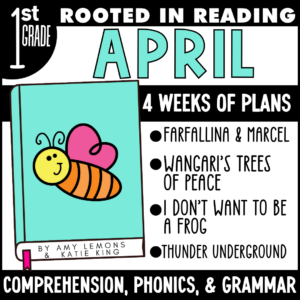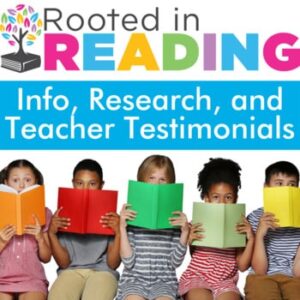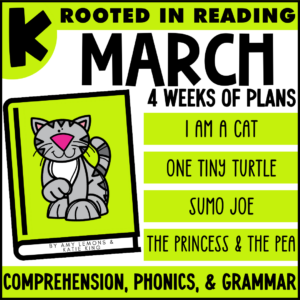$16.50
Also included in:
Rooted in Reading Kindergarten: The Bundle
Calling all Kindergarten Teachers who are ready to TRANSFORM their ELA block! Rooted in Reading for Kindergarten gives you everything you need to facilitate a love of reading in your classroom. We’ve got lesson plans, activities, crafts, and printables that focus around a read-aloud story each week. The teacher READS the book throughout the week and models how to think deeply, ask questions, monitor comprehension, and so much more. Each week we focus on different comprehension skills and strategies that will take your little learners on a reading journey like never before. All lesson plans and activities are aligned with the Common Core Standards and TEKS. This can be used as a stand alone curriculum OR as a supplemental curriculum. You can do ALL of what we include or pick and choose the activities that work best for you and your students! Want to know more? Check out below!
For more information, research, and teacher testimonies on Rooted in Reading click HERE.
***This teaching resource is available as part of a BUNDLE. You can find that by clicking HERE!
The description below AND the PREVIEW are VERY detailed. We have tried to provide as much information as possible! Please check out the description and preview if you have any questions about the unit!
Books needed for January (In order of how we suggest teaching the books):
The Way Home for Wolf by Rachel Bright
Loud Winter’s Nap by Katy Hudson
The Rabbit Listened by Cori Doerrfeld
A Stone Sat Still by Brendan Wenzel
KINDERGARTEN Rooted in Reading Units:
Rooted in Reading Kinder August: Now Available
Rooted in Reading Kinder September: Now Available
Rooted in Reading Kinder October: Now Available
Rooted in Reading Kinder November: Now Available
Rooted in Reading Kinder December: Now Available
Rooted in Reading Kinder January: Now Available
Rooted in Reading Kinder February: Now Available
Rooted in Reading Kinder March: Now Available
Rooted in Reading Kinder April: Now Available
Rooted in Reading Kinder May: Now Available
Ⓠ What is included in the JANUARY unit?
Ⓐ: Look below!
● Daily Lesson Plans for 4 Weeks
● Book Question Cards
● Reading Sentences/Sentence Stems
● Comprehension Assessment
● Take Home Readers that Match the Nonfiction Reader Topic
● Comprehension Focuses:
Identify and Discuss Story Elements
Use Dialogue to Describe a Character
Using Illustrations to Monitor Comprehension
● Comprehension Printables/Interactive Notebooks:
Story Elements Digital Poster
Story Elements Printable
Setting Digital Poster
Setting Images
Setting Printable
Character Feelings Digital Poster
Character Feelings Flap-Ups
Dialogue Digital Poster
Speech Bubble Printable
Using Dialogue to Describe a Character Digital Poster
Character Flap-Up
Instead of Said Digital Poster
Instead of Said Printable
Illustrations Digital Poster
Picture Walk Digital Poster
Illustrations Printable
Animal Actions Printable
Illustrations Printable
Opposites Digital Poster
Opposites Printable
Illustrations Draw and Label Printable
Making Connections Digital Poster
Making Connections Printable
● Nonfiction Readers
These come in a printable and projectable version. There is a NF reader that the teacher READS with the students. There is also a Take-Home reader that the students read with on-level content.
Arctic Animals
Hibernating Animals
Emotions
Tide Pools
● Anchor Charts
The Anchor Charts have all pieces included needed to make the anchor chart as well as cards for students to respond with.
Animals of the Arctic
Story Elements for The Way Home for Wolf
Let’s Describe Tortoise
Animals That Hibernate
The Rabbit Listened Retell
We Have Emotions
The Stone Sat Still Monitoring Comprehension
All About Tide Pools
● Vocabulary
4 Vocabulary Picture Cards with Definitions for each book
4 Vocabulary Writing Prompts
Vocabulary Anchor Chart with picture cards
Vocabulary Picture/Word Match
● Directed Drawings (with writing pages)
The directed drawings have step by step picture instructions for the teacher to guide the students through.
Wilf the Wolf
Tortoise
Rabbit
Snail on a Rock
● Crafts (with writing pages)
The crafts include a printable version that can be colored AND a cut/glue option.
Narwhal
Groundhog
Emoji
Hermit Crab
● Foundational Skills: Short Vowels
– Vowel Digital Posters
– Vowel Tents
– Short Vowel Anchor Charts
– Short Vowel Mini-Books
– Medial Vowels Printables
– Basic CVC Word Printables
– Treasure Hunt Medial Vowels Printables
– Spin a Medial Vowel Printables
● Grammar: Prepositions of Place
Prepositions Digital Poster
Where does the moth fly activity
Where did the wolf go? Activity
Where are the snowflakes falling? Activity
Preposition Printable
Preposition Assessment
● Grammar: Prepositions of Position
Prepositions Digital Poster
Preposition Picture Cards
Where Does the Tortoise Sleep Activity
Groundhog on the Go Activity
Which is Which? Printable
Pick the Preposition
Preposition Assessment
● Grammar: Prepositions
Prepositions Digital Poster
Preposition Match
Preposition Flap-Book
Preposition Sort
Prepositions in Sentences
Prepositions Assessment
● Grammar: Articles
Articles Digital Poster
Articles Anchor Chart
A or An Printable
A or An Writing Words Printable
Choose the Article Printable
Articles Assessment
● Daily Deep Dive: Mentor Sentence
Each week we take a sentence from the book or inspired by the book. This sentence is the anchor for the sentence study.
Pocket Chart Sentence Cards to Build the Sentence Together
Replacing Words Cards
Printable: Write the Sentence and Draw a Picture
Printable: Cut and Glue the Sentence. Write the Sentence.
More FREQUENTLY ASKED QUESTIONS
Ⓠ There is SO much included, how do I fit it all in?
Ⓐ: Please do NOT feel like you have to do everything we put into the units. We try to include everything that a teacher might want, but we realize it is A LOT! We suggest combing through the units, looking at the expectations of your school/district/state, and deciding which activities would be best for your students. We do NOT recommend printing class sets of everything, hoping to get to it all. Choose the things that you think YOUR students need, that will be most beneficial, and start there! Several components can be used during stations, for morning work, or even as homework. Others you may choose to just set aside for another time or not use at all! That’s okay! We want this to work for you AND your students!
Ⓠ What is included in the Kinder units
Ⓐ: Each book unit (so 4 a month) will include:
⇢Daily Lesson Plans for Comprehension, Vocabulary, Grammar, and the Daily Deep Dive
⇢Book Question Cards for Classroom Discussion
⇢Comprehension Focus Digital Posters
⇢Comprehension Printables and/or Interactive Notebook Templates
⇢Comprehension Assessment for the Weekly Read Aloud
⇢Reading Passage with Questions
⇢Anchor Chart Templates
⇢Nonfiction Reader
⇢Nonfiction Take Home Reader
⇢Vocabulary Picture Cards with Word, Picture, Definition
⇢Vocabulary Writing Prompts
⇢Vocabulary Writing Prompts
⇢Vocabulary Printables/Assessments
⇢Craft with Writing Pages
⇢Directed Drawing with Writing Pages
⇢Foundational Skills Focus Digital Posters
⇢Foundational Skills Printables/Activities
⇢Grammar Focus Digital Posters
⇢Grammar Printables/Activities
⇢Daily Deep Dive with Mentor Sentences
Ⓠ How are these units different from your other grade level units?
Ⓐ: We have followed the same format as our other grade levels, but we have made it developmentally appropriate for a Kindergarten classroom. We do not choose read alouds that are on a Kindergarten reading level because the teacher is reading the story to the class, and guiding their discussions, BUT the activities that correlate with the read aloud are Kinder appropriate. We believe that books read aloud should vary in level so that ALL students benefit from the instruction. Here are some minor differences in the Kinder units:
➧Lined Writing Pages and Sentence Starters
➧Printables have very little cutting involved. If there is cutting, it is very basic.
➧Many options for drawing or writing when responding to the text
➧Foundational Skills Included
➧Directed Drawings have simplified steps and a starting page
➧Crafts are easy to cut and assemble or they can simply be colored
➧Vocabulary Cards have pictures
➧Kinder appropriate activities, assessments, passages, and more
Please note: We provide resources/printables for foundational skills. However, we do not claim that this is a complete phonics program. Rooted in Reading was built to address the comprehension, vocabulary, and language standards. Many schools and districts have very specific plans for foundational skills/phonics. Our goal is to simply provide extra materials for teachers to use during their phonics instruction.
Only logged in customers who have purchased this product may leave a review.



Reviews
There are no reviews yet.